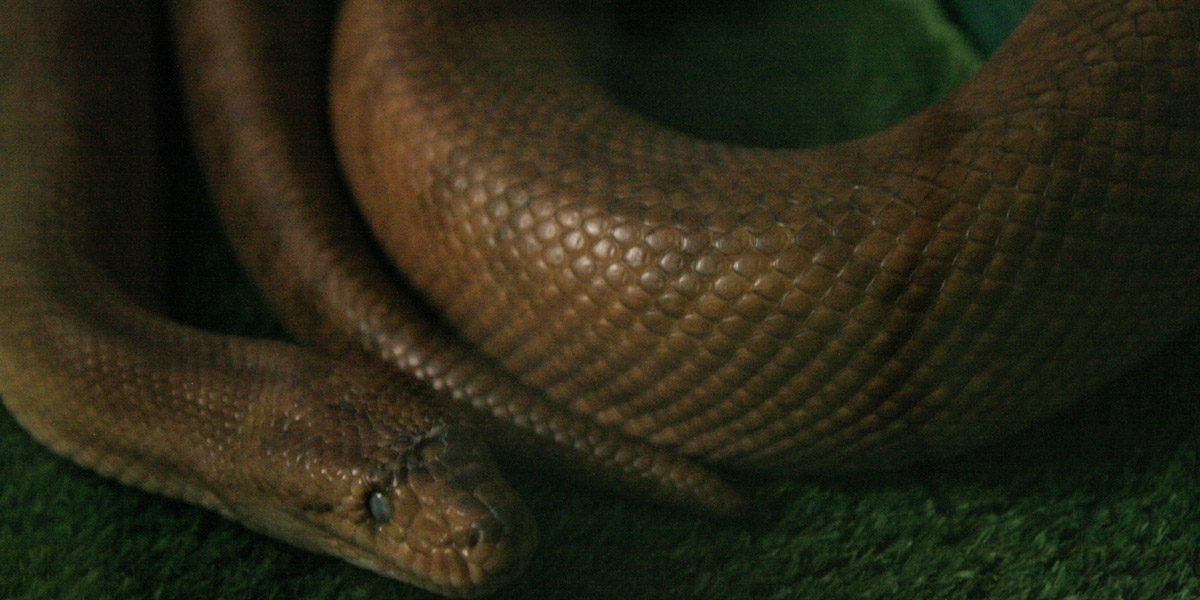

This article was written by Connor, one of our founding editors. Connor is a full-time travel and lifestyle photographer with extensive experience in the outdoors industry.
Choosing to keep a snake as a pet can be scary but equally rewarding. Owning a snake comes with the responsibilities any pet owner can expect and choosing a good snake terrarium is one of those.
There are a variety of styles, shapes, and sizes of snake terrariums on the market and of course, some are better than others. Deciding which is the best snake terrarium can depend on your pet’s species, size, and activity level.
For this guide on some of the top-rated pet reptile terrarium, we’re going to show you some of the best ones when it comes to safety and creating the right environment for a snake. We’ll also include a variety of sizes so that it covers a range of needs.
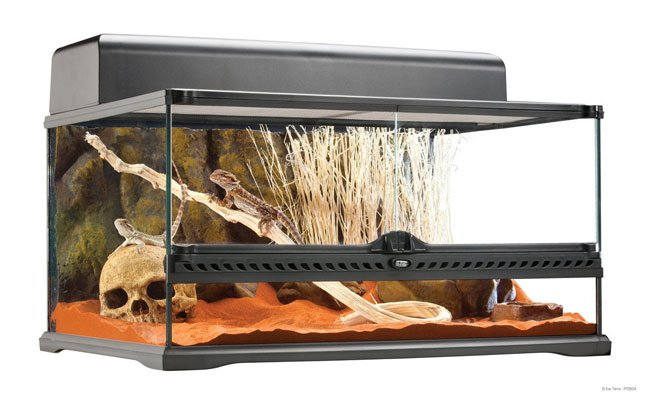
Exo Terra is well-known for producing high-quality snake and reptile enclosures and this one is no different. Being short and wide, this is better suited to ground-dwelling snakes, rather than arboreal ones.
The dimensions are 24x18x12 inches. We love that it has front opening doors which makes getting access to and feeding your snake much easier. The doors can either be opened together or separately and a specially designed lock prevents your snake from sneaking out. Moreover, the ventilated roof can be removed for cleaning and decorating purposes.
This reptile enclosure provides plenty of versatility for decoration. At the back, there are five closable tube/wire inlets which means that you could install things like heat rocks or sensors.
The bottom of the enclosure can fit a substrate heater if you want to heat certain parts of the terrarium floor for your snake. Overall, this enclosure comes in at around 20 gallons which provides ample space for placing rocks and other objects you’d like to use for decoration.
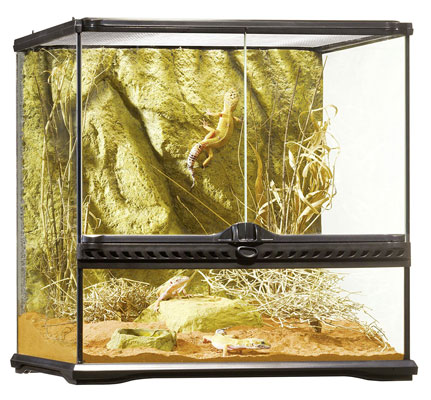
The closest alternative to the short enclosure is Exo Terra’s tall terrarium. You can expect an equivalent quality in terms of versatility and flexibility as this terrarium is one of the top-rated ones you can purchase.
If you click the link to check the product on Amazon, there will be a variety of sizing options. Feel free to click through them and get an idea of what will work for your snake. For example, the one we’re linking to is tall (and wide) and therefore better suited to arboreal snakes i.e. ones which like to climb vines and branches.
Again, there are escape-proof front opening doors so that you can access and feed your snake easily. Additionally, the front window has a ventilation strip. Just like the smaller terrarium from Exo Terra, the bottom is raised so that you can install substrate heating. There are also inlets so that you can install additional features.
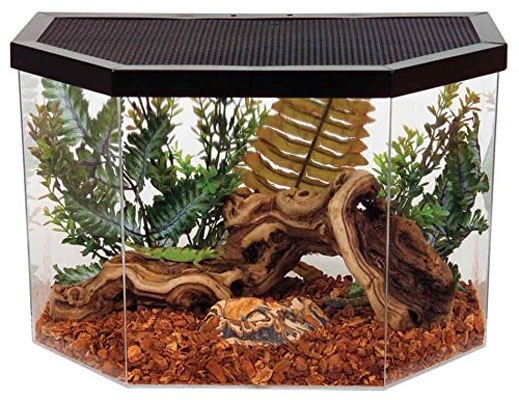
Moving away from Exo Terra, this time we’re taking a look at KollerCraft’s flat-backed reptile enclosure, ideally suitable for ground-dwelling snakes.
This is a much smaller habitat (5 gallons) and that’s reflected in the price, which is $30.95 at the time of writing this guide. One of the best things about this enclosure is that the shape of it provides really good viewing.
The dimensions are 10x19x12 inches which lends itself well to smaller snakes. This product is highly durable. The screen top is made from heavy-duty metal and the rest is made from impact-resistant acrylic, which is ideal if you have children running and playing around it.
One concern that we have with this product is that the lid is not snap on. It is placed on with a latch, which in most instances is perfectly fine, but it does mean that a determined pet snake could push its way out. One way to combat this would be to secure the lid down with a heavy object.
Some people have also had complaints of the side scratching easily, so it is advised that you take care when decorating, handling, and cleaning.
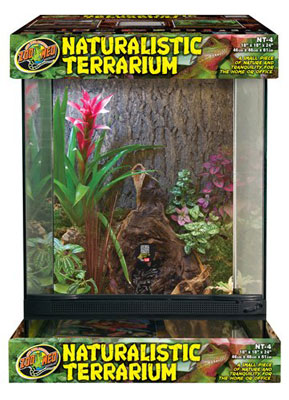
Based on some Amazon reviews, we want to preface this with that you will have a great tank, so long as it doesn’t arrive with cracked glass. The reviews stating that they received a cracked enclosure are from 2015, so it suggests that the problem with the glass may have been fixed. Nonetheless, it is worth keeping in mind.
This is a tall terrarium (18x18x24 inches) which suits arboreal snakes well. This leaves room to add taller features, like vines and branches. The front glass is an opening door that has a secure snap closure. The door is also lockable, however, the lock isn’t actually included so you would need to purchase that separately.
The screen top is made from stainless steel which is durable, resists corrosion, and you can even fit a dome clamp lamp or light bar. Furthermore, the top, as well as the front, is ventilated to keep the terrarium airy.
There are six power cord inlets that you can use to install additional features. The terrarium comes on its own i.e. no lighting, background, etc.
One concern that we have with this product is that the lid is not snap on. It is placed on with a latch, which in most instances is perfectly fine, but it does mean that a determined pet snake could push its way out. One way to combat this would be to secure the lid down with a heavy object.
Some people have also had complaints of the side scratching easily, so it is advised that you take care when decorating, handling, and cleaning.
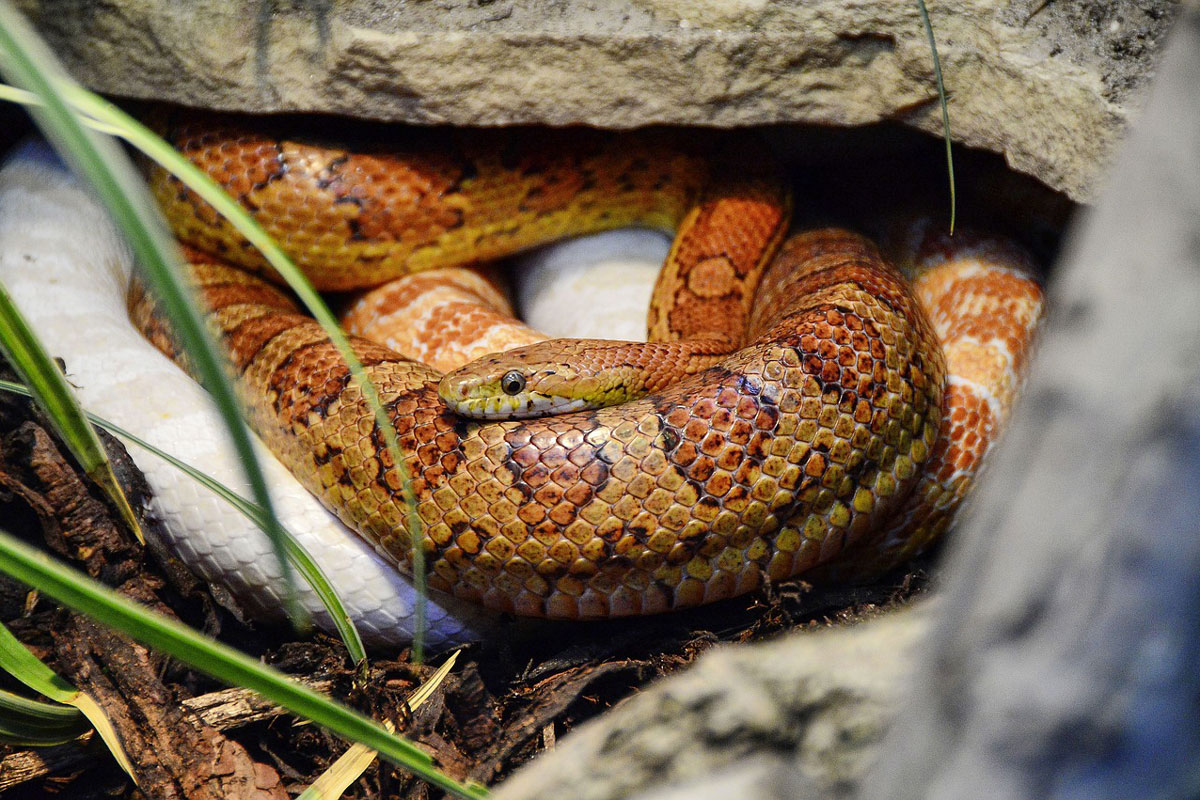
Choosing a snake terrarium, also known as a snake cage, requires thought before you jump to the ‘buy’ button, especially if this is your first pet snake. Whether or not this is your first snake, you need to be ready for your terrarium to actually house a snake.
Essentially, we mean that you need to consider substrate, lighting, heating, size, hiding places, and plants. Once all of that is in place, you are ready to move your snake into the terrarium.
Furthermore, have you learned how to handle your snake safely? This can be really useful so that you protect yourself from a bit and potentially, more importantly, don’t frighten or hurt your snake.
One of the most common misconceptions about good snake enclosures is the belief that ‘bigger is better’. It’s pretty natural to assume that if a snake has more room to move around, then that must be better for the snake’s wellbeing. The truth is, if an enclosure or cage is too large for the snake then it can become anxious.
Additionally, an arboreal snake, i.e. one which lives primarily in trees and bushes, will be better suited to a taller enclosure. Contrarily, a ground-dwelling snake will much prefer a smaller but wider cage. People often look for some crazy terrarium ideas. Although they look great, they might no always be that suited to your snake.
Before transferring your snake over to its new enclosure, or if it’s your first snake, before buying the enclosure, you should consider how you’re going to kit it out. The aim of any enclosure is to mimic its natural environment as closely as possible so that it feels safe and comfortable.
Of course, this means that you’ll need to take some time to learn about your species of snake and its natural habitat. Most often, people opt for different types of sand, gravel, and mulch in order to replicate what it used to in the wild. Some also successfully use newsprint, or cheap newspaper, because it is easy to keep tidy but it is generally better to try to make the habitat as natural as possible for the snake.
In the wild, snakes prefer to hide rather than sit out in the open. This means that you need to think carefully about the placement of rocks, branches, and vines in your snake cage so that there are adequate places for it to hide or climb.
As an example, a ground-dwelling snake will show a preference for plenty of rocks and a branch or two to climb. Other snakes, like arboreal ones, prefer to have more branches and vines to climb.
Snakes love to hide. Naturally, they avoid danger when they can and do this by hiding under rocks, logs, and leaves. In the wild, these are all natural forms of “caves”, essentially. When you’re building out your snake cage, you should aim to replicate a natural hiding place which can be made from rocks or even card.
Buying a snake hide is very important for making your pet snake feel comfortable, as its natural instinct will be to hide from potential predators. Just because your snake is in an enclosure, doesn’t mean it will lose the instinct to be under cover.
As a snake owner, you should always aim to replicate the natural environment of your snake, for its overall health. In the wild, snakes will typically avoid open areas, moving from one hide to the other in search of food. Many pet snake owners make the mistake of only providing one hiding spot.
A lot of snake owners complain that their snake has unexplainably stopped eating. Although this can be for a wide variety of reasons, one of the main ones is due to a lack of hiding space. By providing your snake with ample protection, you will increase the likelihood of it eating more regularly.
You should aim to have two hides for your snake – one in a warm area and the other at a cooler area of the vivarium. This way, when it needs to warm up, it can move happily to the warmer hiding place and vice versa.
The hide you place in the enclosure should remain in place when the snake bumps against it or is going in and out. Furthermore, it’s best to avoid cardboard as a material since this can soak up liquids like urine and water, making it more prone to harbor bacteria.
A good reptile hide is one that can be washed easily and is durable, like stone or plastic. There’s nothing wrong with having a homemade hide, so long as you make sure that it isn’t transparent and isn’t too large that the snake feels uncomfortable with the amount of room it has.
There are plenty of myths flying around when it comes to properly lighting your snake’s cage. The most common myth? You need UVB lights for your snake to survive. This is simply not true, however, the good news is that it certainly won’t hurt. The confusion comes from other reptiles, like green iguanas, which do need UVB lights in their cages.
Snake actually obtain their vitamin D through the foods they eat, rather than needing it through the special light produced by the sun. That said, there is some evidence suggesting that snakes can be seen to be more active under UVB/A light but they’re equally as healthy without it.
If you choose to install a UVB light, make sure that your snake can’t get too close to it, don’t keep it on all day long, and make sure that there is nothing resting against it. Consider using a reflector to sit in front of the light.
Needing heat lights in the terrarium boils down to the species of snake and the temperature it needs to maintain. Heading pads are popular among many owners. They sit under the tank to keep it warm enough for the snake.
Heat lights, however, allow you more control over the average temperature and can also allow for a more natural day/night cycle which is what the snake would be used to in its natural habitat.
Often, people choose to have two different lights. One is left on for 12 hours during the day and is a white light used to mimic daylight. The other light is a nocturnal light, switched on overnight, and is usually purple or red.
If you don’t have a natural day/night cycle, your snake can become confused and display anxious or even lethargic behavior. This is especially true for nocturnal snakes. Additionally, this is one of many reasons snakes actually stop eating.
The larger the snake enclosure, the more watts you’ll need to heat it up. A weak light in a large tank would mean that your snake doesn’t get enough warmth. It’s useful to use a thermometer to assess the temperature of the enclosure relatively regularly.
Having a water bowl for your vivarium is far too often overlooked.
Your snake should always have clean and accessible drinking water. There are mixed opinions on the subject, with some saying that you should give your snake water three or so times per week.
It is easier, though, just to make sure that it always has access to water because you never know when it’s going to want to drink. Snakes, being secretive, will also tend to drink when nobody is around which is a further reason for having a constant water bowl in the vivarium.
You should get a plastic water bowl from a pet store that is big enough for your snake to soak in if it chooses to do so. Bear in mind that some snakes do this when they’re coming up to their shedding cycle. If your snake does this a lot, then you need to be ready to clean out the bowl more often.
Extra tip: if your snake is spending a lot of time soaking, the enclosure’s humidity levels might be too low!
Since snakes can come from all parts of the world, they’re used to a variety of humidities. This is why, as a pet snake owner, you need to be able to control and monitor the humidity of the snake cage effectively. Due to the wide variety of snakes and humidities, it’s impractical for us to list everything you’d need to know, though you should definitely do the research on this.
You may find that you actually don’t need to do that much to the humidity levels, especially if your room’s humidity is around that of what the snake should have. If you’re not that lucky though, then this is what you should do:
Sometimes snakes can have difficulty in shedding their skin and this can often be fixed by paying attention to the humidity of the cage. In captivity, when humans can intervene, this isn’t usually much of a problem but a snake that can’t shed its skin properly without help can result in serious health conditions.
If your snake is struggling to shed its skin, then it will usually be one of two issues – it is either dehydrated or the humidity in the enclosure is too low. Make sure that your pet has easy access to drinking water all the time as this will help with the shedding process.
You can also help the process along by increasing the overall humidity of either the room in which the enclosure is kept or increasing the humidity of the enclosure itself. If your snake has retained some of the skin from its shed, you should soak it for an hour by using a moisture box and gently pull the dead skin away.
If you’re a first-time snake owner and you’ve not yet chosen one for your enclosure, then this section will help you. Choosing the right kind of snake is as much about being fair to you and your family as it is being fair to the snake.
It is important to recognize that there is no definitive list when it comes to choosing what the best snakes for pets are since it really boils down to personal preference. People are often attracted by the more exotic and possibly dangerous snakes at first but you would soon learn that they don’t always make the best pets.
It is better to choose a tame snake that is known to have good temperaments and unwilling or unlikely to bite. Moreover, for the snake’s health, you want to choose a snake that can cope well when living in captivity so long as they are well looked after. The health of some snakes deteriorates under such conditions rendering them inappropriate as pets.
One of the most popular pet snakes is the corn snake. Their size is relatively small, averaging out at around 5ft meaning you don’t need a particularly large enclosure. The best corn snake terrarium length should be about 2/3 that of its body length.
Additionally, corn snakes deal well with being handled by humans and are unlikely to bite. For some, it might take a short amount of time to become accustomed to human contact but they should become tamer even after just one week.
In terms of their eating habits, corn snakes tend to happily feed off frozen rodents (mice, rats, etc.) which makes feeding them much easier. Finally, as long as you look after your snake well, this species often lives a relatively long life without any problems.
Gopher snakes are known to have extremely great temperaments, especially when raised from a young age. This makes it an ideal species for first-time snake owners. Averaging at around 6ft in length, the gopher snakes feed well and will also happily live off frozen rodents.
Although most gopher snakes will grow to possibly just over 6ft, some species are known to grow up to a foot longer than this. Make sure to do your reading beforehand and be willing to get a bigger enclosure if needed. Most of them will happily fit into a 4×2 cage.
Gopher snakes are known to have extremely great temperaments, especially when raised from a young age. This makes it an ideal species for first-time snake owners. Averaging at around 6ft in length, the gopher snakes feed well and will also happily live off frozen rodents.
Although most gopher snakes will grow to possibly just over 6ft, some species are known to grow up to a foot longer than this. Make sure to do your reading beforehand and be willing to get a bigger enclosure if needed. Most of them will happily fit into a 4×2 cage.
The kingsnake, or more specifically the California kingsnake, is one of the most popular pets snakes because of its good size and behavior. They normally grow to around 4-6ft in length and stay healthy and happy in captivity.
One reason the kingsnake is such a popular species as a pet is due to the variety of subspecies available, such as the grey-banded kingsnake, the Florida kingsnake, and the mountain kingsnake to name a few. Each has distinctively different colors and marking which makes them attractive to different kinds of people.
Like the corn snake and gopher snake, kingsnakes love to feed off frozen rodents. This is handy because frozen rats and mice are usually fairly easy to buy in bulk – saving you money and time in preparation.
Another hugely popular pet snake is the ball python although they are known to be a bit fussier with their eating. That said, most are happy enough with frozen rodents. Some, however, are known to refuse and prefer fresher rodents which means you can’t buy the food in bulk.
The ball python is a good size, growing to an average of five to six feet which makes them perfect for keeping in captivity. Most importantly, their temperament is excellent, and are very reluctant to go for a bite given they’re handled properly.
Want to choose a ball python? If so, you’re going to be looking after it for a while because they can live for 25 years or even more in some cases. This is because they maintain their health and thrive in a captive environment if they are well looked after.